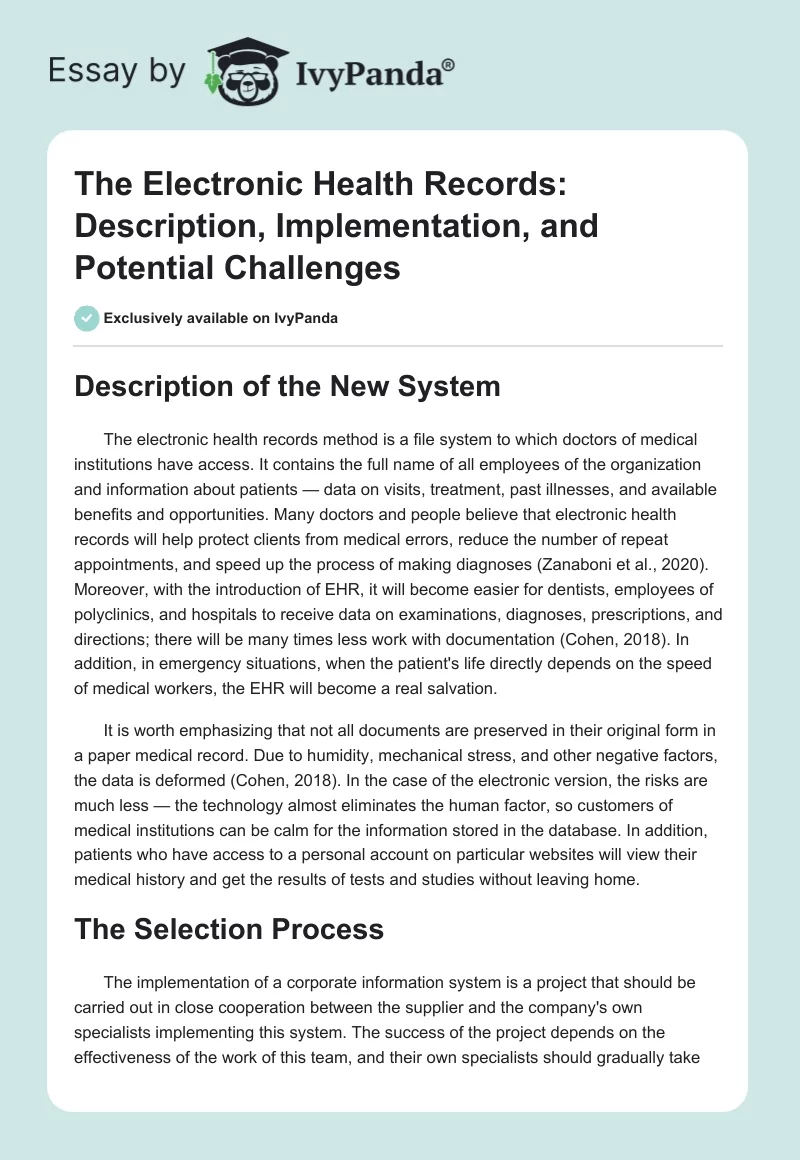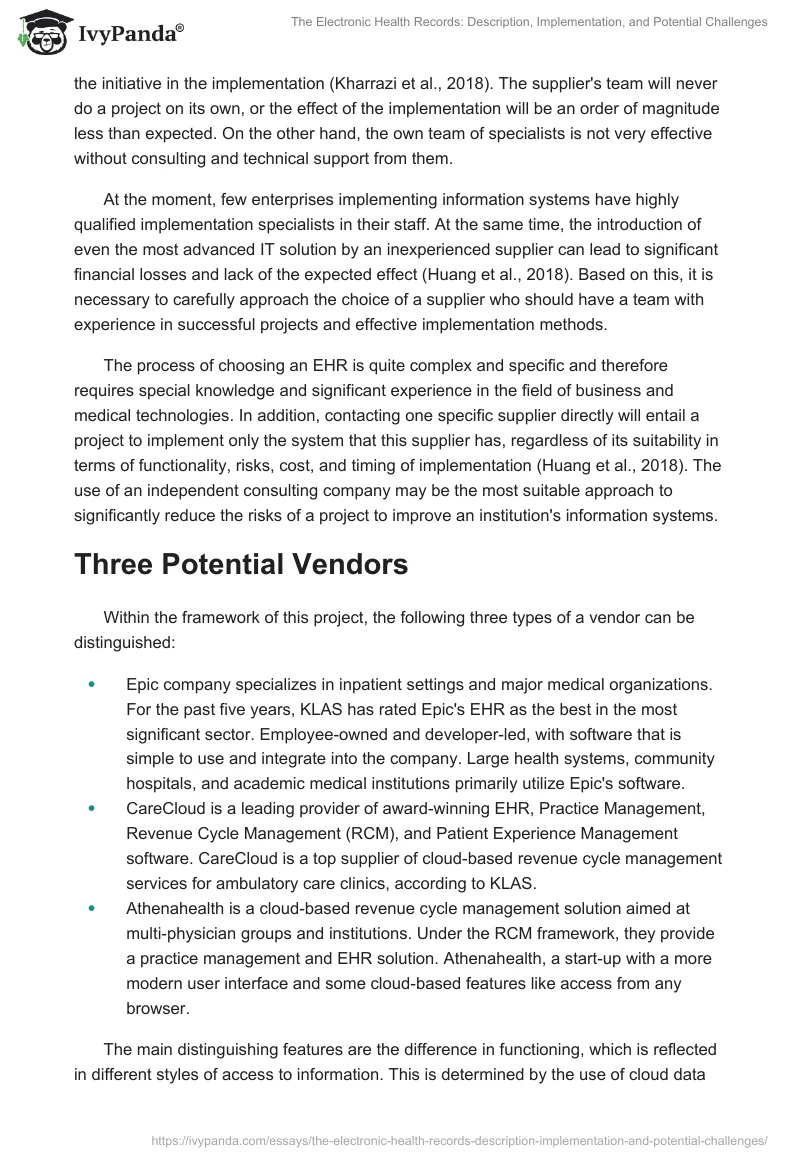Description of the New System
The electronic health records method is a file system to which doctors of medical institutions have access. It contains the full name of all employees of the organization and information about patients — data on visits, treatment, past illnesses, and available benefits and opportunities.
Many doctors and people believe that electronic health records will help protect clients from medical errors, reduce the number of repeat appointments, and speed up the process of making diagnoses (Zanaboni et al., 2020). Moreover, with the introduction of EHR, it will become easier for dentists, employees of polyclinics, and hospitals to receive data on examinations, diagnoses, prescriptions, and directions; there will be many times less work with documentation (Cohen, 2018). In addition, in emergency situations, when the patient’s life directly depends on the speed of medical workers, the EHR will become a real salvation.
It is worth emphasizing that not all documents are preserved in their original form in a paper medical record. Due to humidity, mechanical stress, and other negative factors, the data is deformed (Cohen, 2018). In the case of the electronic version, the risks are much less — the technology almost eliminates the human factor, so customers of medical institutions can be calm for the information stored in the database. In addition, patients who have access to a personal account on particular websites will view their medical history and get the results of tests and studies without leaving home.
The Selection Process
The implementation of a corporate information system is a project that should be carried out in close cooperation between the supplier and the company’s own specialists implementing this system. The success of the project depends on the effectiveness of the work of this team, and their own specialists should gradually take the initiative in the implementation (Kharrazi et al., 2018). The supplier’s team will never do a project on its own, or the effect of the implementation will be an order of magnitude less than expected. On the other hand, the own team of specialists is not very effective without consulting and technical support from them.
At the moment, few enterprises implementing information systems have highly qualified implementation specialists in their staff. At the same time, the introduction of even the most advanced IT solution by an inexperienced supplier can lead to significant financial losses and lack of the expected effect (Huang et al., 2018). Based on this, it is necessary to carefully approach the choice of a supplier who should have a team with experience in successful projects and effective implementation methods.
The process of choosing an EHR is quite complex and specific and therefore requires special knowledge and significant experience in the field of business and medical technologies. In addition, contacting one specific supplier directly will entail a project to implement only the system that this supplier has, regardless of its suitability in terms of functionality, risks, cost, and timing of implementation (Huang et al., 2018). The use of an independent consulting company may be the most suitable approach to significantly reduce the risks of a project to improve an institution’s information systems.
Three Potential Vendors
Within the framework of this project, the following three types of a vendor can be distinguished:
- Epic company specializes in inpatient settings and major medical organizations. For the past five years, KLAS has rated Epic’s EHR as the best in the most significant sector. Employee-owned and developer-led, with software that is simple to use and integrate into the company. Large health systems, community hospitals, and academic medical institutions primarily utilize Epic’s software.
- CareCloud is a leading provider of award-winning EHR, Practice Management, Revenue Cycle Management (RCM), and Patient Experience Management software. CareCloud is a top supplier of cloud-based revenue cycle management services for ambulatory care clinics, according to KLAS.
- Athenahealth is a cloud-based revenue cycle management solution aimed at multi-physician groups and institutions. Under the RCM framework, they provide a practice management and EHR solution. Athenahealth, a start-up with a more modern user interface and some cloud-based features like access from any browser.
The main distinguishing features are the difference in functioning, which is reflected in different styles of access to information. This is determined by the use of cloud data storage or on the basis of the organization itself. Moreover, a distinctive characteristic may be the price for the services of use. In general, it should be noted that the principles of operation within different systems are almost the same. Within the framework of this project, the first vendor – Epic, will be selected due to the fact that it is already a relatively reliable and popular solution.
Qualitative Return on Investment Analysis
EHR system deployment in primary care offices is considered particularly tough, with physicians and other staff reporting challenges such as difficulties adapting to significant changes in workflow. Moreover, it is necessary to learn to utilize the new software while prioritizing patient care. There is a certain set of criteria that determine the viability of investments made in the system. The following are examples of quantifiable benefits:
- Increased revenue: this is usually due to improved medical coding and billing accuracy. The more precise the billing, the more likely the practice will be compensated appropriately for its services.
- Increased clinician productivity: because the EHR system streamlines visit notes, physician prescriptions, follow-ups, and billing, the clinician may be more productive. The majority of encounter notes may be done at the point of service, increasing efficiency and ensuring documentation correctness.
Non-quantifiable benefits include:
- Improved work satisfaction for doctors and employees: if the personnel is acquainted with the EHR system, their job responsibilities should be more streamlined. There will be less duplication of effort and less time-consuming activities, allowing them to concentrate on patient care. This will result in higher work satisfaction, a better retention rate, and improved practice morale.
- Circumstantial variables across the healthcare spectrum result in varied outcomes, making a consistent ROI story challenging to construct. The kind of facility, the size of the institution, the specific practice or sector of care, the number of the workforce, and the EHR products themselves all have a role in generating an ROI (Tsai et al., 2020). However, most authors and specialists in the field of healthcare information technology arrive at a conclusion.
Strategies and Potential Barriers to Success
At the moment, a wide range of software is available, designed for use as automated management systems of the organization. Each of the software complexes is designed to solve various tasks, has its advantages and disadvantages. Nevertheless, not every implementation of EHR is successful, as evidenced by the statistics (Tsai et al., 2020). The main difficulties with the implementation of information systems are related to three key aspects:
- The capabilities of the system laid down by its developers and configuration.
- The level of training of specialists involved in the implementation of the system.
- The degree of readiness of the enterprise for implementation and the features of its structure.
For successful implementation of the system in the institution, it is necessary to pay attention to the following essential strategies:
- structured implementation goals and objectives that will be addressed in the framework used EHR
- a clear description of all without exception of procedures to be performed within the processes of medical institutions
- descriptions of the measures to control the execution of procedures
- use a systematic approach at all stages of the life cycle of the connected system.
Implementation Plan
- Create a plan for implementing the EHR:
- The first step in any EHR implementation strategy is to list all the activities and processes that your team of physicians, practice managers, and IT personnel will need to accomplish.
- Assemble a committee to oversee the implementation of the EHR:
- It is necessary to assemble a team of interested people responsible for the budget, conditions, and time frame.
- Estimate the cost of implementing the EHR and set a budget.
- Data migration for patients and practices:
- The following are essential phases in EHR data migration:
- Paper records are being converted to electronic records.
- Validation and cleaning of data.
- Setup of the EHR database.
- Data mapping from historical sources to new database fields.
- Transfer of data to the new system.
- Validation and testing of existing data.
- New data inputs are tested and verified.
- The following are essential phases in EHR data migration:
- Develop a program for user training:
- It is necessary to provide a training program for all specialists involved in the institution. This will undoubtedly take time, during which the staff will need to familiarize themselves with all the features of the EHR.
- Identify essential success elements as well as assessment methods:
- EHR implementation evaluation can take several forms, and the appropriate one for the organization will be determined by the project goals:
- Calculate the return on investment (ROI) to determine profitability.
- To evaluate efficiency, keep track of patient throughput.
- To evaluate the quality of care, conduct a patient satisfaction survey.
- To measure user uptake and training, survey physician satisfaction.
- Assess data entry and quality by analyzing data error rates.
- EHR implementation evaluation can take several forms, and the appropriate one for the organization will be determined by the project goals:
References
Cohen, D. J. (2018). Primary care practices’ abilities and challenges in using electronic health record data for quality improvement.Health affairs (Project Hope), 37(4), 635–643.
Huang, M. Z., Gibson, C. J., & Terry, A. L. (2018). Measuring electronic health record use in primary care: A scoping review. Applied Clinical Informatics, 9(1), 15–33.
Kharrazi, H., Gonzalez, C. P., Lowe, K. B., Huerta, T. R., & Ford, E. W. (2018). Forecasting the maturation of electronic health record functions among US hospitals: Retrospective analysis and predictive model.Journal of medical Internet research, 20(8), e10458.
Tsai, C. H., Eghdam, A., Davoody, N., Wright, G., Flowerday, S., & Koch, S. (2020). Effects of electronic health record implementation and barriers to adoption and use: A scoping review and qualitative analysis of the content. Life (Basel, Switzerland), 10(12), 327.
Zanaboni, P., Kummervold, P. E., Sørensen, T., & Johansen, M. A. (2020). Patient use and experience with online access to electronic health records in Norway: Results from an online survey.Journal of medical Internet research, 22(2), e16144.


